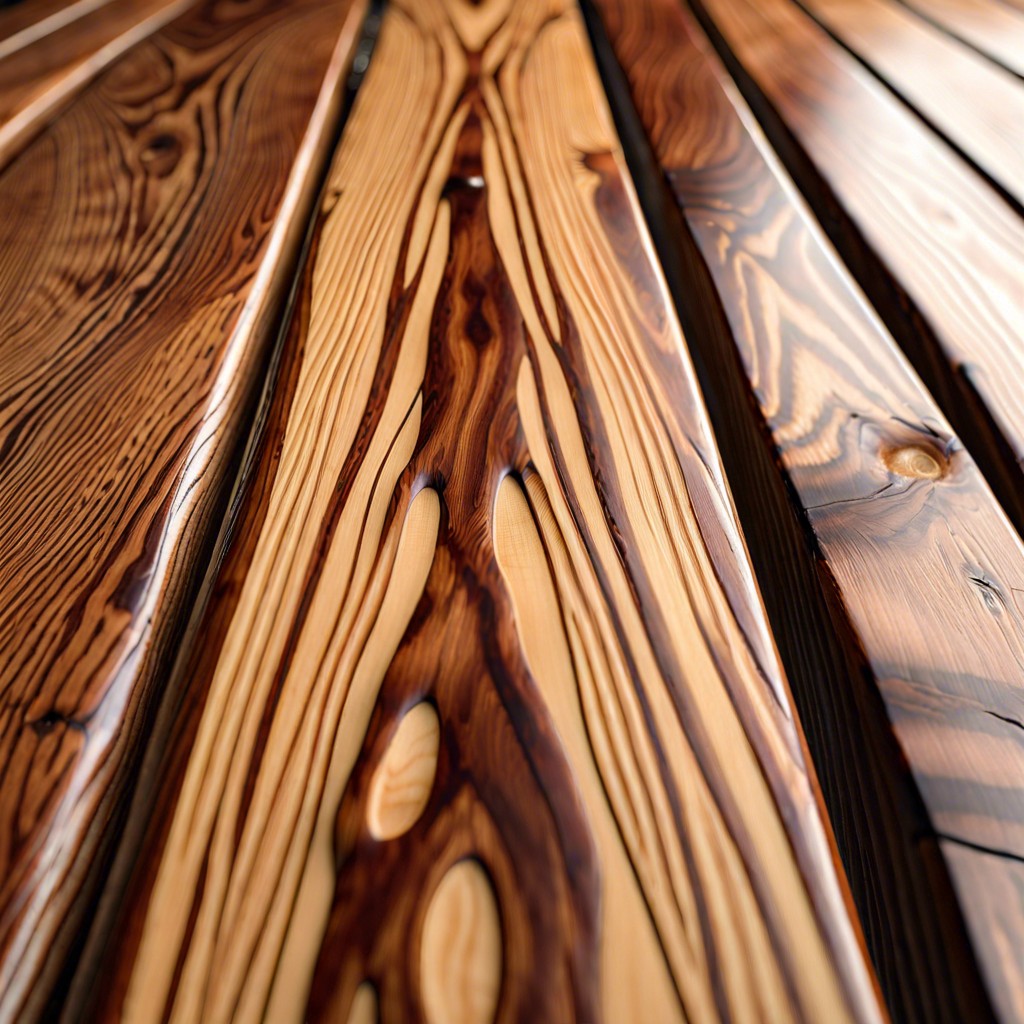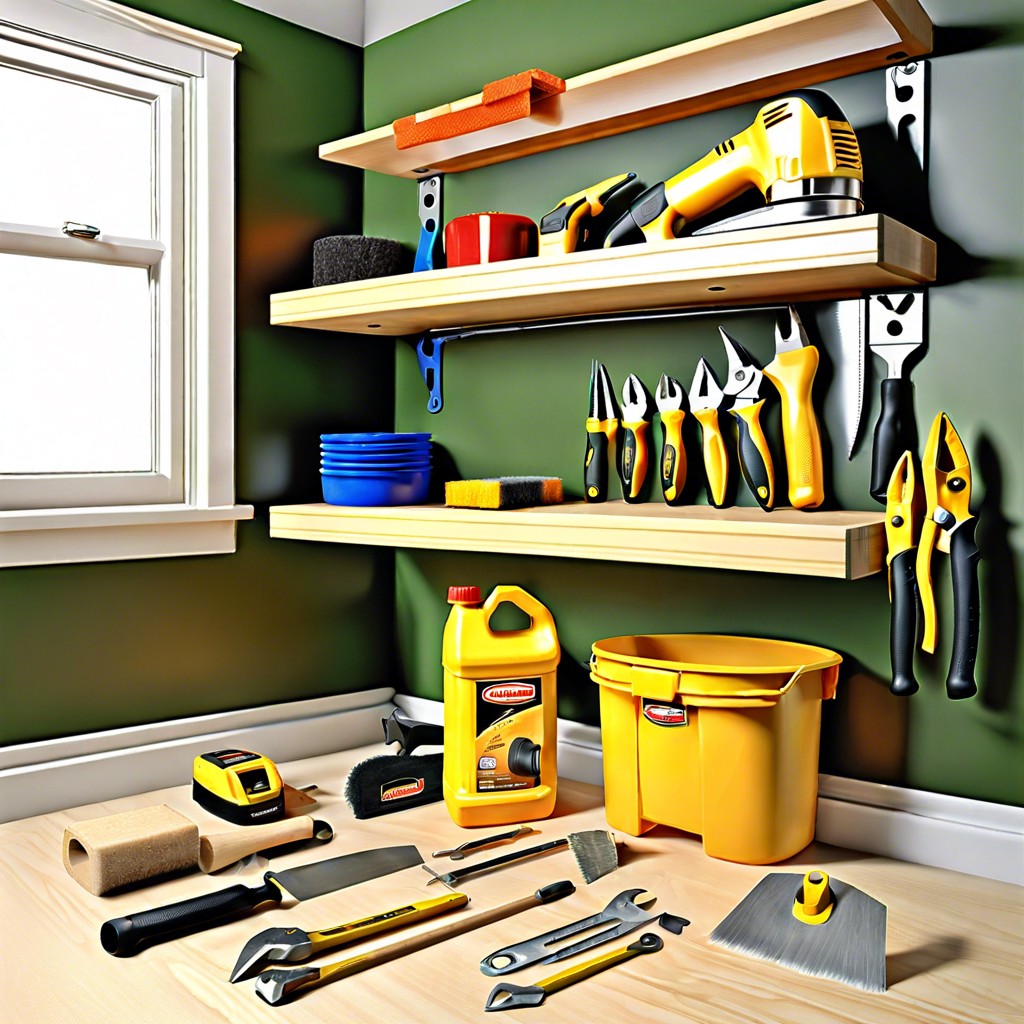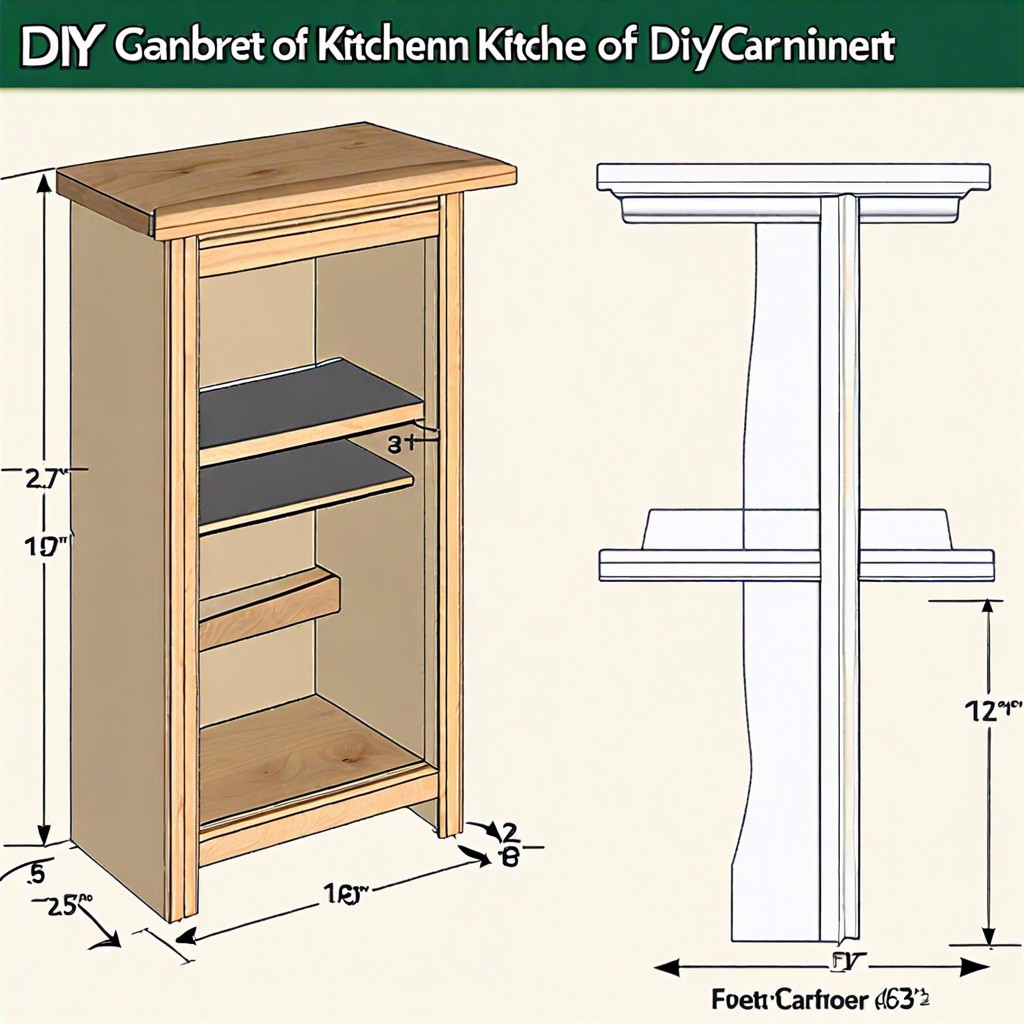Last updated on
Hidden outlets are transforming residential and commercial spaces because they merge functionality with aesthetic appeal, and we’re diving into a comprehensive guide on how to install and utilize them effectively.
Key takeaways:
- Paintable screwless wall plates: seamless design, easy access, durable.
- Colored receptacles: match wall color, consider texture, prioritize quality and safety.
- Under cabinet power strip: integrated design, easy accessibility, flexible installation.
- Pop-up outlets: flush installation, convenient access, enhanced safety, customizable.
- Specialty finish faceplates: seamless integration, luxurious materials, antimicrobial options.
What's Inside
Paintable Screwless Wall Plates
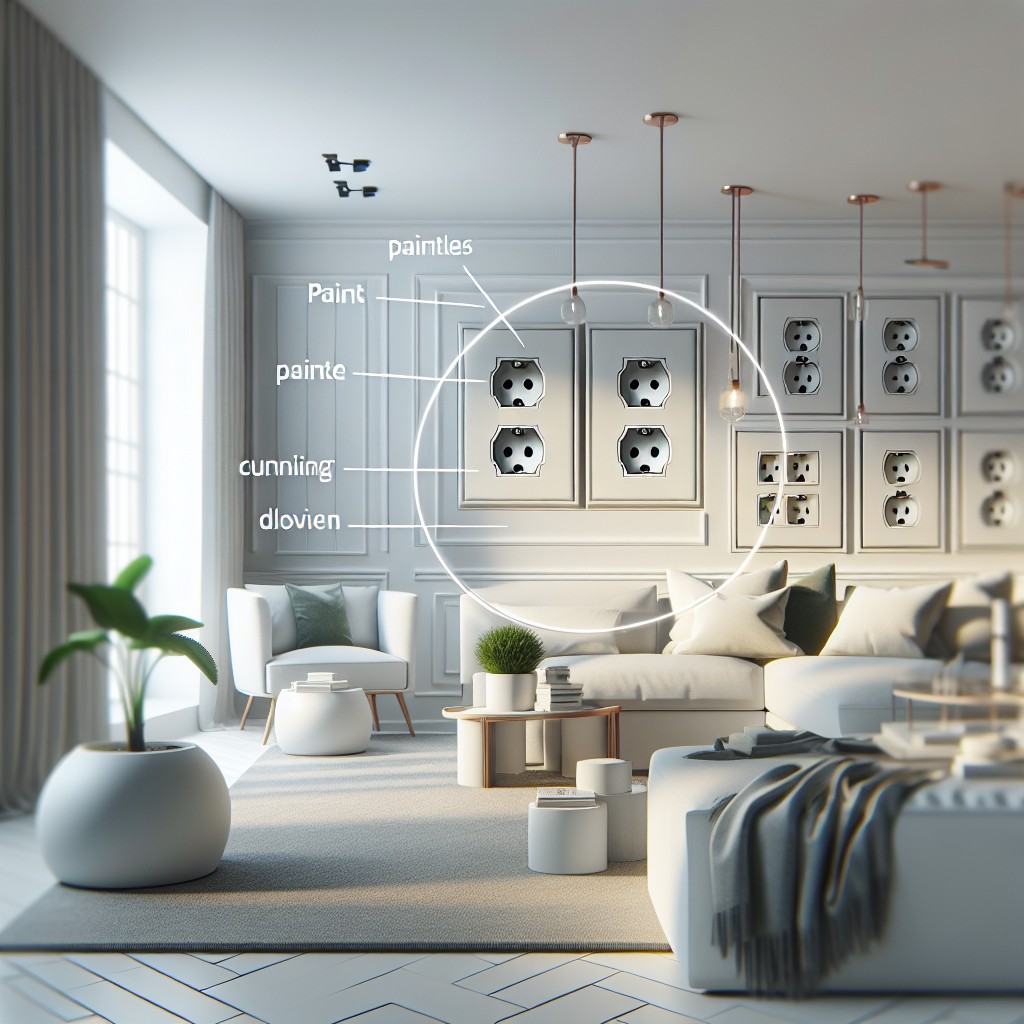
In the quest for a sleek, uninterrupted design, paintable screwless wall plates are an ideal solution. These innovative covers attach to the outlet with a plate that snaps onto a frame, eliminating the need for visible screws. The paintable surface allows you to seamlessly blend your outlets with any wall color or texture, ensuring they don’t detract from your room’s aesthetic.
Consider the following when incorporating them into your space:
- Match your wall texture: Use the same paint and texture technique on the wall plates for a perfect camouflage.
Ease of access: Despite their discrete appearance, these plates are easy to remove when you need to plug something in.
Compatibility: They fit standard outlets and can be paired with dimmers or switches for a consistent look throughout the room.
Durability: Crafted from high-quality materials, these plates resist wear and tear, protecting your outlets over time.
By keeping these points in mind, you’ll maintain the beauty of your space while having fully functional outlets whenever you need them.
Colored Receptacles
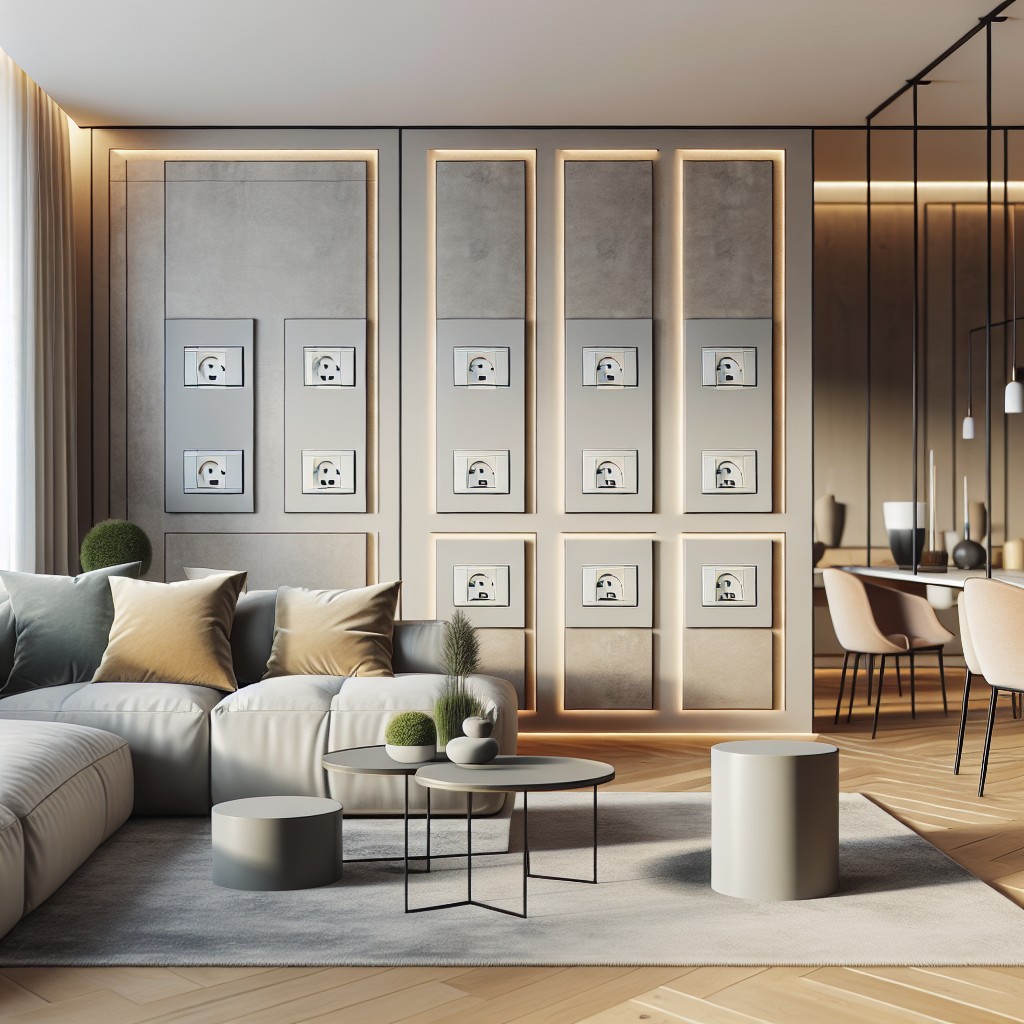
Integrating colored receptacles offers a subtle yet effective approach to camouflage outlets against your walls. Homeowners can select colors that closely match their backsplashes or wall paint, ensuring outlets blend seamlessly into the design scheme.
When choosing a receptacle, consider the following:
- Wall Color Match: Select outlets in a shade identical or complementary to your wall color to minimize visual interruption.
- Texture Consideration: For textured walls, find receptacles with a similar finish to maintain a consistent look.
- Consistency: Use the same colored receptacles throughout a room for a uniform appearance.
- Quality and Safety: Always opt for high-quality receptacles that meet safety standards to ensure functionality isn’t compromised.
By thoughtfully selecting colored receptacles, you create a streamlined aesthetic that maintains the functionality of your outlets without detracting from your interior design.
Under Cabinet Power Strip
Tucked away under kitchen cabinets, these power strips offer a sleek solution to keep countertops clear. Here are key points to know:
- Integration: They seamlessly blend into your kitchen design, making them virtually invisible when not in use.
- Accessibility: Devices are easily plugged in without the visual clutter of traditional wall outlets.
- Design Flexibility: Available in various lengths and configurations, they accommodate the specific power needs of your space.
- Lighting Advantage: Some models include integrated LED lighting to illuminate countertops, adding functionality.
- Easy Installation: Most versions can be simply attached under the cabinet and plugged into an existing wall outlet, minimizing the need for complex electrical work.
By moving electrical access points from the wall to under the cabinet, you maintain the aesthetic appeal of your backsplash while keeping power within reach.
Pop-up Outlets
Elevating both functionality and aesthetics, pop-up outlets seamlessly blend into modern kitchens and offices. These clever devices remain out of sight until needed, at which point they can be easily accessed with a simple press.
Here are some key points to consider:
- Integration and Installation: Pop-up outlets are installed flush with countertops or desks, making them nearly invisible when not in use.
- Convenience: They offer easy access to power for appliances and charging personal devices without the need for extension cords across the room.
- Safety: A major benefit of pop-up outlets is their contribution to safer spaces, reducing tripping hazards and keeping the area clear of dangling cords.
- Customization: There’s a wide variety of styles and finishes available, ensuring that these outlets can match any room’s decor.
- Space-Saving: Particularly valuable in areas with limited wall space, pop-up outlets provide power without compromising on space or design.
Understanding these points sheds light on why pop-up outlets are a smart choice for those looking to maintain the clean lines and organized appearance of their living or workspaces.
Specialty Finish Faceplates
Embracing the aesthetic component of outlet design, specialty finish faceplates offer a seamless integration with your interior decor. These stylish covers range from brushed nickel to oiled bronze, catering to a variety of room themes. Whether you’re aiming for a modern, minimalist look or a more rustic vibe, there’s a finish to match.
Consider these points:
- Specialty finishes can mirror the textures and colors of your walls, creating a harmonious look.
- Some faceplates are available in materials like wood, leather, or stone, blending perfectly with luxurious surfaces.
- Choosing antimicrobial finishes can be a practical choice for areas keen on cleanliness, such as kitchens and bathrooms.
- When selecting faceplates, remember that while aesthetics are important, they should also meet the required safety standards for electrical fixtures.
Flush Mount Self-Contained Receptacles
Incorporating flush mount self-contained receptacles offers a streamlined and sophisticated touch to your spaces, especially where traditional outlets might protrude or disrupt clean lines. These fittings sit even with the wall, banishing the bulk of standard outlets and presenting a neat finish.
Key points to understand about flush mount outlets include:
- Installation Precision: Proper installation is crucial, requiring exact cutouts in the drywall to ensure a seamless appearance.
- Compatibility: They are compatible with various wall finishes, but may require specialist faceplates for thicker materials like marble or granite.
- Aesthetic Appeal: These receptacles are less noticeable, making them ideal for installation in prominent locations like living rooms or home offices.
- Safety: They often come with child-proofing features, as the flat face does more to deter curious little fingers than standard outlets.
- Functionality: Some models offer additional functions such as USB charging ports, adding convenience without compromising design.
Selecting flush mount outlets can elevate a room’s sophistication, merging function with finesse for a clutter-free and contemporary aesthetic.
Charging Station Drawer
Integrating a charging station drawer into your space keeps countertops clutter-free and ensures devices are powered up and ready when needed. Here’s how it works:
- A specially designed drawer is fitted with multiple USB and standard power outlets to accommodate various devices.
- To install, an electrician routes power to the desired location, ensuring all safety protocols are met, transforming a regular drawer into a discreet charging hub.
- Devices can be charged out of sight, reducing cord clutter and maintaining the aesthetic of the room.
- These drawers often include organizing compartments or docks, preventing devices from sliding around.
- Ideal for kitchens, offices, or nightstands, this solution supports a minimalist design approach and maximizes functionality.
Consider a charging station drawer as an innovative way to improve the flow and tidiness of high-traffic areas.
How to Hide Existing Electrical Outlets in the Kitchen
Camouflaging existing electrical outlets in the kitchen doesn’t require a complete overhaul. Here are practical steps:
1. Use appliance garages: these small cabinets are designed to hide small appliances as well as their outlets, keeping your counters sleek.
2. Apply adhesive covers: blend outlets with your backsplash by using adhesive covers that mimic the pattern and color of your tiles.
3. Install under-cabinet lighting: these systems often come with integrated outlets that are hidden from view, leaving your backsplash uninterrupted.
4. Paint outlets: for outlets against painted walls, carefully paint the outlet covers to match your wall color, making them less conspicuous.
5. Rearrange furnishings: where possible, rearrange countertop appliances, storage containers, or decorative items to obscure any outlets.
6. Employ decorative objects: place a small vase or a cookbook stand in front of an unused outlet to conceal it without any structural changes.
7. Swap outlet plates: replace traditional ones with borderless or paintable covers to reduce visual impact.
Each of these steps allows you to minimize the visual clutter of outlets with minimal effort and without compromising on functionality.
Outlet Options to Consider When Designing/Remodeling
Considering outlet options during the design or remodeling phase ensures that electrical access is conveniently integrated without compromising aesthetics. Here are a few points to keep in mind:
1. Plan for Usage: Identify where you’ll use small appliances, charge devices, or require power for lighting. Plot these areas early to ensure outlets are where they’re needed.
2. Future-Proof with USB: Opt for outlets with built-in USB ports in high-use areas, like kitchens and bedrooms, to cater to the ever-growing number of USB-powered devices.
3. Assess Countertop Spaces: For kitchen islands or workspaces, think about pop-up or under-cabinet outlets that maintain a clean look and only appear when needed.
4. Consider Furniture Placement: Account for where furniture will be situated and install floor outlets beneath or near sofas and tables for seamless power access.
5. Evaluate Appliance Locations: In areas with major appliances, ensure outlets are placed where they can be hidden by the appliance itself for a sleeker look.
6. Safety First: For bathroom or outdoor spaces, make sure to include GFCI outlets to protect against moisture-related electrical hazards.
7. Go with the Flow: Align outlet placement with the room’s workflow, especially in utility spaces, to avoid awkward reaching or extension cords.
8. Lighting Integration: For a modern touch, include recessed outlets where you can directly plug in wall sconces or overhead lights, eliminating the need for visible wiring.
9. Low-Profile Options: Consider flush-mount outlets that sit in line with the wall surface for a nearly invisible look that blends with your wall texture or pattern.
10. Color Match: Choose outlets and covers that match the wall color or backsplash to make them less noticeable.
Early consideration of these elements in the design process can greatly enhance the functionality and harmony of your living space.
Flush Mount Hidden Outlets
Integrating flush mount hidden outlets into your space provides a seamless look that doesn’t interfere with your home’s aesthetic. These outlets sit perfectly level with the wall surface, making them nearly invisible when not in use. With a variety of cover options, including ones that can be painted or wallpapered over, you can ensure these electrical sources blend into any design effortlessly.
For installation, these outlets require an electrical box that is set back slightly from the wall studs, allowing the faceplate to align with the wall’s surface. The customization doesn’t end at installation; covers often come with a magnet or touch latch system that gives you quick access to power when you need it, while maintaining a discrete appearance when you don’t.
Here are several advantages of choosing flush mount outlets:
- Aesthetic Appeal: They maintain the integrity of a room’s design, avoiding visual interruptions caused by protruding outlets.
- Safety: Reducing the chance of snagging or tripping over plugs, they also keep curious little ones at bay, offering an extra layer of safety.
- Versatility: These outlets can be installed in various locations, including within cabinets, under counters, or on mantlepieces, providing power without the clutter of wires.
- Innovation: Some models even include smart technology, allowing for remote control of the outlet through home automation systems.
When planning for flush mount outlets, it’s essential to consider the location and frequency of use, as they are best used in areas where you won’t be constantly plugging and unplugging devices. Ensure that your design choices align with the functionality to get the most out of this sleek and modern solution.
FAQ
What is a hidden outlet?
A hidden outlet is a non-functioning electrical outlet that features a concealed compartment designed for securely storing valuables such as jewelry, cash, and credit cards.
Do wireless outlets exist?
Yes, wireless outlets exist, with an example being the Top Greener In-Wall Smart Wi-Fi USB Charging Outlet.
Are floor outlets legal?
Yes, floor outlets are legal, but must comply with the National Electrical Code by being part of an approved assembly that includes a metal box, gasket seal, special receptacle, and a strong cover plate with a moisture-proof cover.
How safe are hidden outlets in a household setting?
Hidden outlets, when installed and used correctly, are generally safe for use in a household setting.
Can hidden outlets be installed in all types of walls?
Yes, hidden outlets can be installed in all types of walls, regardless of material or structure.
What are the best locations to install floor outlets to ensure safety and convenience?
The best locations to install floor outlets are near walls and furniture where they won’t pose a tripping hazard, yet remain accessible for convenience.


